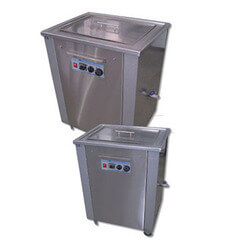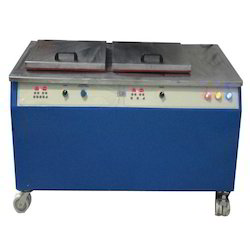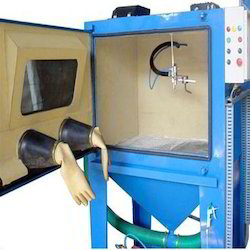As an esteemed name in the relevant industry, we are offering a precision-engineered array of Ultrasonic Mold Cleaners. Following industry defined guidelines, we manufacture the entire range by utilizing contemporary machines, modernize technology and prime grade raw material. In order to ensure quality, the entire range is rigorously tested upon a series of parameters. In tune with clients’ diverse requirements, we offer the entire range in a wide range of specifications.


Being a client-centric organization, we are engaged in offering a distinct collection of Ultrasonic Mold Cleaning Machines. Our skilled professionals manufacture these machines using well-tested raw materials and sophisticated technology. In addition to this, our offered range is rigorously tested by our quality controllers against diverse parameters in order to deliver a defect-free range at clients end. Ultrasonic Mold Cleaning Machine which cleans the components through multi-stage ultrasonic cleaning and rinsing processes. Moreover, the offered range is extensively appreciated by our clients for featuring variegated attributes like easy installation and durability.
Owing to our state-of-art manufacturing unit and the usage of leading-edge technology, we are able to present a comprehensive range of Mold Cleaning Machines.

Ultrasonic mold cleaners are specialized devices used for cleaning molds in various industries, including manufacturing, plastics, food processing, and pharmaceuticals. Molds can accumulate residues, contaminants, and debris during the manufacturing process, which can affect product quality, efficiency, and mold lifespan. Ultrasonic mold cleaners provide an efficient and thorough cleaning method for molds. Here’s how they typically work:
Ultrasonic Cleaning Process: Ultrasonic mold cleaners utilize high-frequency sound waves to create cavitation in a cleaning solution. The mold is immersed in the tank filled with the cleaning solution. The ultrasonic waves generate microscopic bubbles that implode near the mold surface, creating intense scrubbing action and dislodging contaminants.
Tank Design: The cleaner’s tank is designed to accommodate the size and shape of the molds being cleaned. It may have adjustable racks, baskets, or trays to hold the molds securely in place during the cleaning process. The tank may also include heating capabilities to enhance cleaning effectiveness, as elevated temperatures can improve the cleaning action.
Cleaning Solution: The cleaning solution used in ultrasonic mold cleaners is critical for effective cleaning. It is typically formulated with specific chemicals that target and remove the contaminants present on the mold surface. The cleaning solution may be water-based or solvent-based, depending on the type of contaminants and the mold material. Some cleaners may require the use of specialized cleaning solutions recommended by the manufacturer.
Ultrasonic Frequency and Power: The ultrasonic cleaner generates high-frequency sound waves in the range of 20 to 40 kHz. The frequency and power settings can be adjusted based on the specific cleaning requirements and the nature of the contaminants being removed. Higher power and frequency can provide more aggressive cleaning action, but the settings should be used within the recommended parameters to prevent damage to the mold surface.
Timer and Controls: Ultrasonic mold cleaners are equipped with timers and controls that allow precise control over the cleaning cycle. The cleaning time can vary depending on the level of contamination and the specific mold type. The controls may also include temperature settings, allowing the cleaning solution to be heated to the optimal temperature for efficient cleaning.
Rinse and Drying: After the ultrasonic cleaning cycle, the mold should be thoroughly rinsed to remove any residual cleaning solution or loosened contaminants. This can be done using clean water or a rinse solution recommended by the cleaner’s manufacturer. Proper drying of the mold is essential to prevent the accumulation of moisture, which can lead to corrosion or further contamination.
Ultrasonic mold cleaners offer several advantages, including thorough cleaning of complex mold shapes, efficient removal of contaminants, and the ability to clean molds without disassembling them. They can help improve productivity, reduce downtime, and extend the lifespan of molds. However, it is important to follow the manufacturer’s instructions, including the recommended cleaning solution, operating parameters, and safety precautions, to ensure safe and effective cleaning and to avoid damage to the molds.
